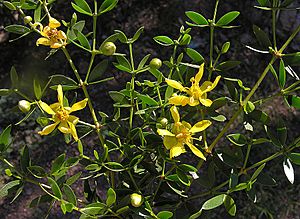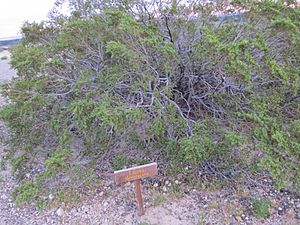Larrea divaricata facts for kids
Quick facts for kids Larrea divaricata |
|
|---|---|
 |
|
| Scientific classification | |
| Genus: |
Larrea
|
| Species: |
divaricata
|
| Synonyms | |
|
|
Larrea divaricata, often called chaparral, is a small evergreen bush. It belongs to the plant family called Zygophyllaceae. This plant naturally grows in dry areas of South America. There, people know it as jarilla or jarillo. A Spanish botanist named Antonio José Cavanilles first described this plant in 1800.
About the Chaparral Plant
The chaparral plant is a slow-growing shrub. It can grow up to 3 meters (about 10 feet) tall. Its stems are round. The leaves are small, dark green, and shaped like an oval. They feel a bit sticky because they have a special resin on them. These leaves grow in pairs, one across from the other.
Bright yellow flowers appear on the plant in October and November. Each flower has five petals. After the flowers, the plant produces dry capsules. These capsules contain soft, grayish hairs and five seeds. When goats eat the leaves and seed capsules, especially when there isn't much grass, they help spread the plant's seeds.
Where Does Chaparral Grow?
The chaparral plant, Larrea divaricata, is special because it only grows in southwestern South America. This means it is endemic to that region. You can find it in countries like Bolivia, Peru, Chile, and Argentina, especially in a region called Patagonia. It likes to grow in open forests, scrubland (areas with many shrubs), and grassy fields.
There is a similar plant called Larrea tridentata that grows in North America. For a long time, people thought these two plants were the same. However, in the 1940s, scientists discovered that they are actually two different species.
Special Uses of Chaparral
The chaparral plant contains many interesting natural substances. Its sticky resin has compounds called lignans. These are plant chemicals that scientists are studying for possible health benefits. The plant also contains other natural compounds like guaiaretic acid, flavonoids, and triterpenes.
Scientists have found that a liquid extract from the chaparral plant can help fight certain germs. For example, it has shown properties against Helicobacter pylori. This is a type of bacteria that can live in the stomach. It is known to cause stomach upset and other digestive problems.
See also
 In Spanish: Larrea divaricata para niños
In Spanish: Larrea divaricata para niños


